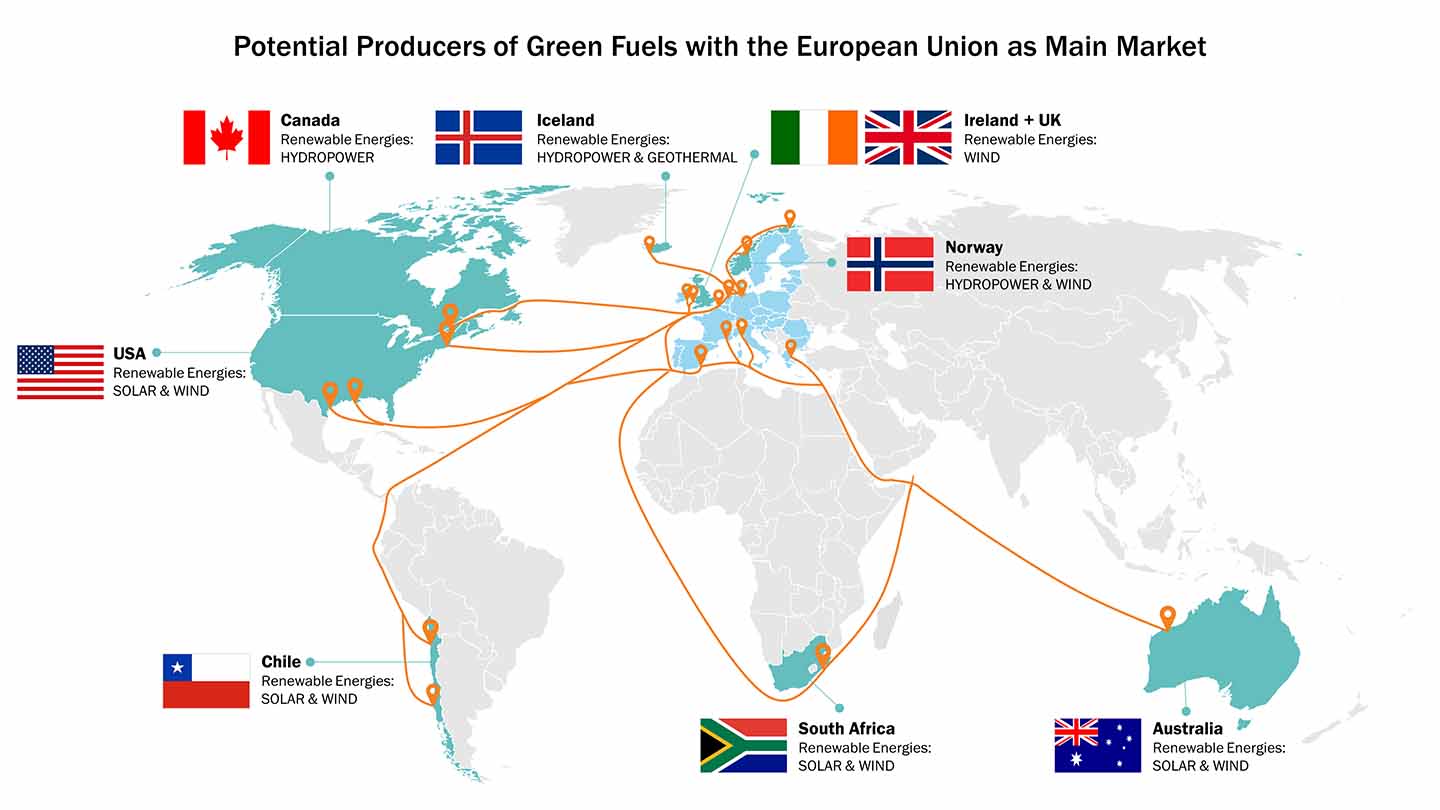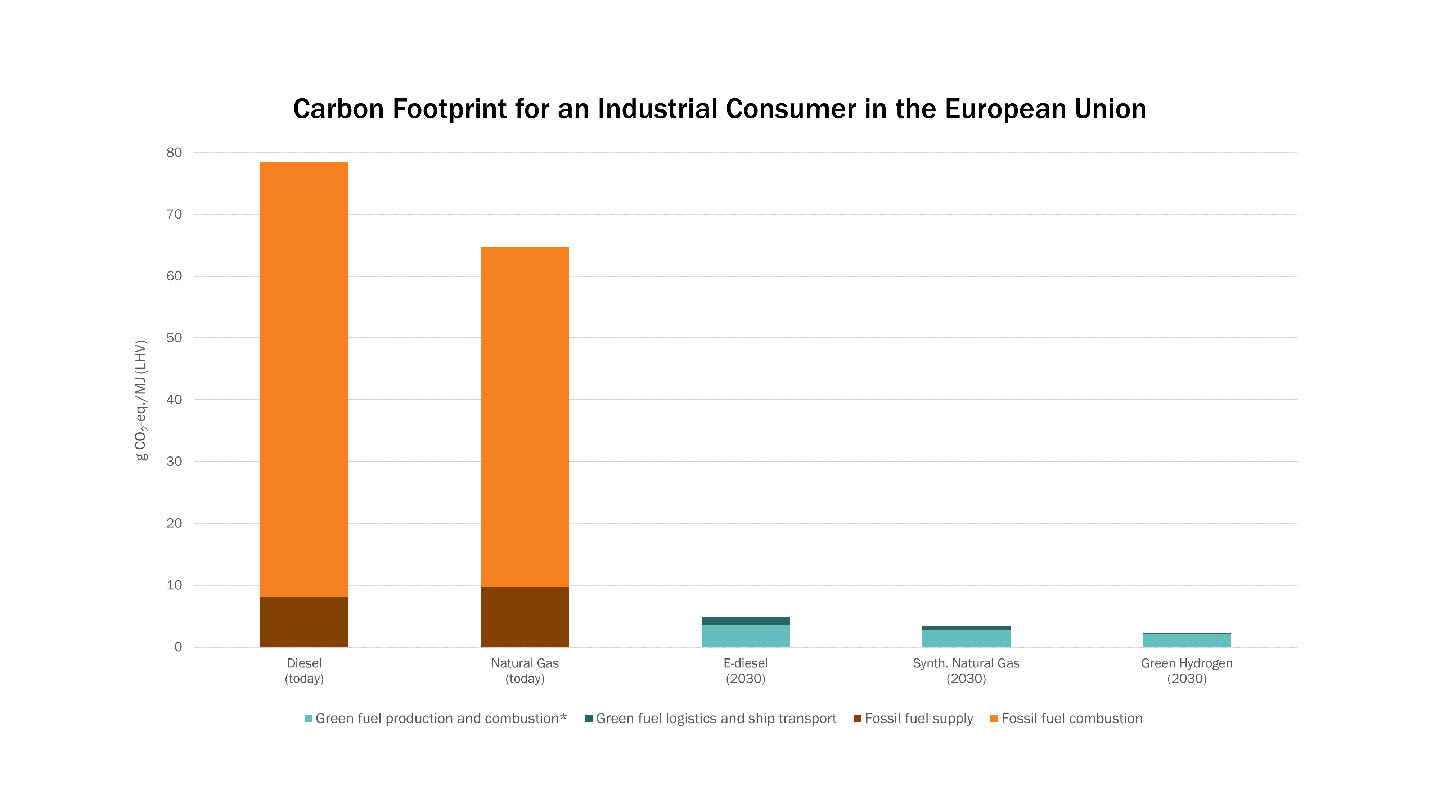The Sixth Assessment Report of the Intergovernmental Panel on Climate Change (IPCC) highlights the urgent need for serious action to combat climate change. Shifting from fossil-based to green fuel sources plays a crucial role in this, but recent sanctions on Russian oil and gas following the invasion of Ukraine demonstrate our continued dependence on fossil fuels. It is increasingly clear that transitioning to green energy sources must happen faster than previously assumed.
The shift to green energy production and import provides the opportunity to reduce supply chain uncertainties, lower greenhouse gas emissions and meet Environmental, Social and Governance (ESG) requirements, all at the same time. The production of green energy sources in democratic countries offers the best way to achieve this.
At Sphera, we have conducted environmental and techno-economic analyses of green fuel production, imports and use in numerous projects. This article gives an overview of green fuels, provides insight into the results of our analyses and offers guidance on how this transition can succeed in a timely manner.
Green Fuel Production
In order to produce green energy, a country must be capable of generating electricity from renewable energies. This requires two things: sufficient sources of natural energy, like wind and solar; and physical space for the installation of electricity and fuel production facilities.
Industrialized countries, such as those in the European Union whose limited space prevents the domestic production of green energy, will continue to import energy to a significant extent.
The following figure shows a selection of countries that are capable of producing hydrogen and synthetic fuels. These countries have excellent conditions for electricity and fuel production from renewable energies. [Note: The selection should be viewed as an example and can be expanded to include other countries.]

Transportation and Import of Green Fuels
Ships are most appropriate for transporting green fuels across long, intercontinental distances, and pipelines are most appropriate for continental distances.
The import of fossil-derived liquefied natural gas (LNG) by ship—which already has and will further expand rapidly—could be supplemented in the short term with so-called synthetic natural gas (SNG), which consists of methane (CH₄) produced from green hydrogen and carbon dioxide (CO2) extracted from the atmosphere.
After arrival at the destination port, liquefied SNG can be converted into gas in the same simple way as LNG. The switch from fossil fuels to synthetically produced liquid fuels (e-fuels, such as e-diesel) can be, in principle, realized in the short term. Here, liquid fuels are produced by means of Fischer-Tropsch synthesis from green hydrogen and CO2 extracted from the atmosphere. Existing oil tankers and oil storage facilities could be used to transport these synthetic liquid fuels.
In the medium term, transporting liquefied hydrogen by ship from producer countries to consumer countries could have real advantages: Compared to SNG and liquid e-fuels, producing fuel from hydrogen is more efficient, it can be transported in ships without greenhouse-gas-producing propulsion systems, and its combustion does not generate CO2. New types of ships and adapted infrastructure are needed for liquid hydrogen transport, however. Wherever new transport terminals are built, liquefied hydrogen transport should be considered.
Today, pipelines for continental fuel transport are highly flexible in their ability to transport natural gas/methane and hydrogen, as well as a mixture of the two. There are also concrete plans in the EU to build new hydrogen pipelines, or to fully convert existing pipelines to hydrogen.
Use of Green Fuel
Green fuels in the form of SNG and liquid e-fuels could directly replace fossil fuels. This is initially the case for electricity generation, heating systems for buildings and mobility applications (as a supplement to battery electric vehicles, e.g., for large vehicles where a switch to fully electric powertrains is not feasible). Additionally, green synthetic fuels would be immediately available for other applications in industry (e.g., as feedstock for chemical products).
Environmental and Economic Potential of Green Fuels
Sphera has investigated the switch to green fuels in numerous projects for industrial customers and in public projects. The following graphs show the potential of green fuels. For this article, we have chosen the obvious example of importing green fuels in the direct vicinity of the EU, assuming a ship transport of 2,300 km (1,429 miles). From an ecological and economic point of view, however, importing green fuels over longer distances (e.g., from Australia to the EU) also makes sense, even if more fuel is consumed by the transporting ship.
Norway, the United Kingdom, Ireland and Iceland have the world’s highest potential for wind energy, and therefore offer excellent conditions for producing green fuels with low greenhouse gas emissions. Electricity generation from wind power therefore serves as the basis. Production of green fuels is assumed to begin in 2030.

The reference values for the fossil fuels were taken from Sphera’s life cycle assessment (LCA) databases and reflect the current state of fuel supply and use in the European Union.
Sphera’s carbon footprint analyses show that under the selected conditions, all considered green fuels result in a massive carbon footprint reduction to below 5 grams carbon dioxide equivalent per megajoule (CO2-eq./MJ) delivered fuel, compared to the fossil fuels used today. The selected examples of e-diesel and SNG could be realized with only minor adjustments to the infrastructure in the consuming countries.

Sphera estimates that, in 2030, renewable synthetic liquid fuels will be in a price range similar to the 2022 conventional diesel market prices. Renewable electricity costs are the main cost drivers for the production of synthetic fuels. We assume these costs be in the range of around two (euro) cents per kilowatt-hour at ideal international conditions. Ship transport of liquid fuels to Europe is already very common and generates comparatively low related costs.
For gaseous fuels, it should be noted that natural gas prices could increase dramatically, depending on international political developments. This has been observed in 2022, as a consequence of the Russian invasion into the Ukraine. If prices increase permanently, synthetic gaseous fuels such as SNG or hydrogen based on renewable electricity could become cost competitive more quickly than expected.
As shown, synthetic fuels based on renewable energy could significantly support the European Union’s transition toward carbon neutrality, while reducing its dependence on the international fossil energy supply. Market conditions, together with political incentives, might favor these alternative fuels sooner than expected.
How Sphera Can Help
With more than 25 years of experience in the field of green fuels, Sphera’s sustainability consultants can evaluate and compare projects and technologies from an environmental and techno-economic point of view in order to promote a targeted and rapid switch to green energy supply and use.

